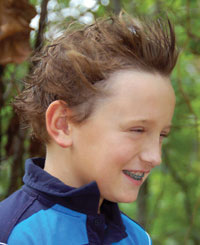What Really Causes—and Prevents—the Common Cold?
By Lynne Long
 The common cold is just that—common. Colds account for more trips to the doctor than any other illness, according to the American Lung Association. Because we spend so much time concocting methods to ward them off, they also account for a healthy proportion of all medical myths. As the annual cold and flu season rages on, UAB pediatrician and microbiologist Wayne Sullender, M.D., and internist Michael Geer, M.D., separate the truth from the fiction.
The common cold is just that—common. Colds account for more trips to the doctor than any other illness, according to the American Lung Association. Because we spend so much time concocting methods to ward them off, they also account for a healthy proportion of all medical myths. As the annual cold and flu season rages on, UAB pediatrician and microbiologist Wayne Sullender, M.D., and internist Michael Geer, M.D., separate the truth from the fiction.
Myth 1: The Name
“People use the term ‘cold’ as a big catchall for the flu, sinusitis, and various upper respiratory problems,” says Geer. “But if you have a fever, it’s probably not a cold.”
Myth 2: Feed a Cold
Although feeling sick may trigger cravings for your favorite comfort food, overeating has no beneficial effects, Sullender says—nor does undereating. “Starvation is not recommended as therapy for colds; consuming sufficient liquids to maintain hydration is suggested.”
Myth 3: Wet Heads
Another common myth goes like this: Head outside with damp hair, and you’ll come back with a cold. Not likely, says Sullender: “Studies in volunteers, including chilling and wearing wet clothes, have not shown that wetness causes colds.” Viruses, especially rhinoviruses, are the most commonly identified source of colds, he adds.
Myth 4: The Power of Supplements
Some people swear that taking large doses of vitamin C or herbs such as echinacea can prevent or relieve cold symptoms, but there is no substantial evidence to support this, says Geer. “Be careful when choosing over-the-counter products for colds,” he warns. “Many make claims they cannot support.” They also pose the risk of potentially harmful interactions with prescription drugs, he notes.
The Truth: An Ounce of Prevention
With more than 100 different types of viable rhinoviruses in circulation, waiting for their chance to infect, a cure for the common cold could be years in the making. But the best defense may be one of the simplest. “Hand washing helps reduce transmission,” says Sullender. This is especially true for young ones, he adds. “A child is often the person who introduces a cold virus into the home.” Geer agrees—from personal experience. “In all of my years in practice, I have never contracted a cold from a patient,” he says. “It’s always from my own kids.”